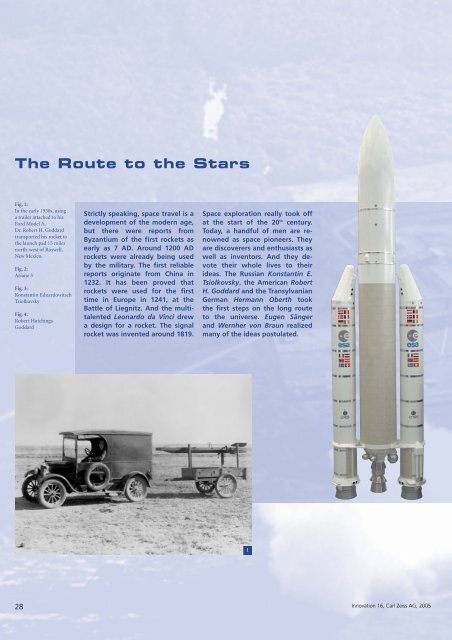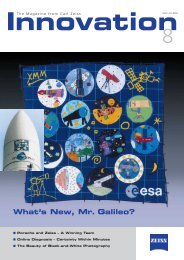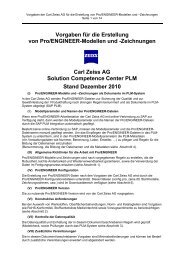Download PDF - Carl Zeiss
Download PDF - Carl Zeiss
Download PDF - Carl Zeiss
Create successful ePaper yourself
Turn your PDF publications into a flip-book with our unique Google optimized e-Paper software.
The Route to the Stars<br />
Fig. 1:<br />
In the early 1930s, using<br />
a trailer attached to his<br />
Ford Model A,<br />
Dr. Robert H. Goddard<br />
transported his rocket to<br />
the launch pad 15 miles<br />
north-west of Roswell,<br />
New Mexico.<br />
Fig. 2:<br />
Ariane 5<br />
Fig. 3:<br />
Konstantin Eduardowitsch<br />
Tsiolkovsky<br />
Fig. 4:<br />
Robert Hutchings<br />
Goddard<br />
28<br />
Strictly speaking, space travel is a<br />
development of the modern age,<br />
but there were reports from<br />
Byzantium of the first rockets as<br />
early as 7 AD. Around 1200 AD<br />
rockets were already being used<br />
by the military. The first reliable<br />
reports originate from China in<br />
1232. It has been proved that<br />
rockets were used for the first<br />
time in Europe in 1241, at the<br />
Battle of Liegnitz. And the multitalented<br />
Leonardo da Vinci drew<br />
a design for a rocket. The signal<br />
rocket was invented around 1819.<br />
Space exploration really took off<br />
at the start of the 20 th century.<br />
Today, a handful of men are renowned<br />
as space pioneers. They<br />
are discoverers and enthusiasts as<br />
well as inventors. And they devote<br />
their whole lives to their<br />
ideas. The Russian Konstantin E.<br />
Tsiolkovsky, the American Robert<br />
H. Goddard and the Transylvanian<br />
German Hermann Oberth took<br />
the first steps on the long route<br />
to the universe. Eugen Sänger<br />
and Wernher von Braun realized<br />
many of the ideas postulated.<br />
1<br />
Innovation 16, <strong>Carl</strong> <strong>Zeiss</strong> AG, 2005
















